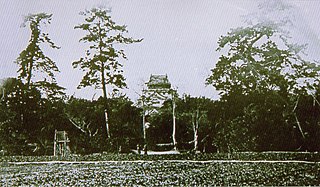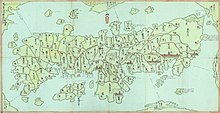
Tokushima Domain was a feudal domain under the Tokugawa shogunate of Edo period Japan, controlling all of Awa Province and Awaji Province in what is now Tokushima Prefecture and Awaji Island of modern-day Hyōgo Prefecture. It was centered around Tokushima Castle, and was ruled throughout its history by the tozama daimyō Hachisuka clan.

Aizu Domain was a domain of the Tokugawa Shogunate of Japan during the Edo period from 1601 to 1871.

The Tosa Domain was a feudal domain under the Tokugawa shogunate of Edo period Japan, controlling all of Tosa Province in what is now Kōchi Prefecture on the island of Shikoku. It was centered around Kōchi Castle, and was ruled throughout its history by the tozama daimyō Yamauchi clan. Many people from the domain played important roles in events of the late Edo period including Nakahama Manjirō, Sakamoto Ryōma, Yui Mitsue, Gotō Shōjirō, Itagaki Taisuke, Nakae Chōmin, and Takechi Hanpeita. Tosa Domain was renamed Kōchi Domain during the early Meiji period until it was dissolved in the abolition of the han system in 1871 and became Kōchi Prefecture.

Oshi Domain was a feudal domain under the Tokugawa shogunate of Edo period Japan, located in Musashi Province, Japan. It was centered on Oshi Castle in what is now part of the city of Gyōda, Saitama.

Morioka Domain was a tozama feudal domain of Edo period Japan. It was ruled throughout its history by the Nanbu clan. It was called Nanbu Domain during the early part of its history. It was located in northern Mutsu Province, Honshū, covering the eastern half of what is now Aomori Prefecture and the northern two-thirds of what is now Iwate Prefecture and the Kazuno District of what is now Akita Prefecture. The domain was centered at Morioka Castle in the city of Morioka. For most of its history, Morioka Domain had an official kokudaka of 100,000 koku, although its actual revenues were much higher. Towards the end of the Edo period, the domain’s status was raised to 200,000 koku.

Mineyama Domain was a feudal domain under the Tokugawa shogunate of Edo period Japan, located in Tango Province in what is now the northern portion of modern-day Kyoto Prefecture. It was centered around the Mineyama jin'ya which was located in what is now the city of Kyōtango and was controlled by a cadet branch tozama daimyō Kyōgoku clan throughout all of its history.

Hirado Domain was a Japanese domain of the Edo period. It was centered around Hirado Castle in what is now the city of Hirado, Nagasaki and was ruled by the tozama daimyō Matsura clan for all of its history.

Himeji Domain was a feudal domain under the Tokugawa shogunate of Edo period Japan, located in Harima Province in what is now the southern portion of modern-day Hyōgo Prefecture. It was centered around Himeji Castle, which is located in what is now the city of Himeji, Hyōgo.

Matsue Domain was a feudal domain under the Tokugawa shogunate of Edo period Japan, in what is now eastern Shimane Prefecture. It was centered around Matsue Castle and was ruled for most of its history by branch of the Matsudaira clan.

Tottori Domain was a feudal domain under the Tokugawa shogunate of Edo period Japan, in what is now Tottori Prefecture on the island of Honshu. It controlled all of Inaba Province and virtually all of Hōki Province was centered around Tottori Castle, and was ruled throughout its history by a branch of the Ikeda clan. Tottori Domain was dissolved in the abolition of the han system in 1871 and is now part of Tottori Prefecture. Tottori Domain had two sub-domains, Shikano Domain (鹿奴藩) and Wakasa Domain (若桜藩). In addition, the two branches of the Arao clan, who served as hereditary karō of the clan and castellans of Yonago Castle and Kurayoshi Jin'ya both had kokudaka equivalents to that of daimyō.

Yanagawa Domain was a feudal domain under the Tokugawa shogunate of Edo period Japan, in what is now eastern Fukuoka Prefecture. It was centered around Yanagawa Castle in what is now the city of Yanagawa, Fukuoka and was ruled by the tozama daimyō Tachibana clan for much of its history.

Nagaoka Domain was a fudai feudal domain under the Tokugawa shogunate of Edo period Japan. It is located in Echigo Province, Honshū. The domain was centered at Nagaoka Castle, located in what is now part of the city of Nagaoka in Niigata Prefecture. It was often referred to as Echigo-Nagaoka Domain to disambiguate itself from the smaller Yamashiro-Nagaoka Domain in what is now Nagaokakyo, Kyoto. The domain was ruled by the Makino clan for most of its history. During the summer of 1868, it was the center of some of the fiercest fighting during the Boshin War. Admiral Yamamoto Isoroku was the son of a Nagaoka samurai.

Kishiwada Domain was a feudal domain under the Tokugawa shogunate of Edo period Japan, located in Izumi Province in what is now the southern portion of modern-day Osaka Prefecture. It was centered around Kishiwada Castle and was controlled by the fudai daimyō Okabe clan throughout much of its history.

Ōgaki Domain was a fudai feudal domain under the Tokugawa shogunate of Edo period Japan. It was located in Mino Province, in the Tōkai region of central Honshu. The domain was centered at Ōgaki Castle, in what is now the city of Ōgaki in Gifu Prefecture. It was ruled for most of its existence by the Toda clan.
Gotō Morinori was the 11th and final daimyō of Fukue Domain in Hizen Province, Kyūshū, Japan. He was the 31st hereditary head of the Gotō clan. His courtesy titles were Ōmi-no-kami, and later Hida-no-kami, and he held lower 5th court rank.

Tateyama Domain was a feudal domain under the Tokugawa shogunate of Edo period Japan, located in Awa Province, Japan. It was centered on Tateyama Castle in what is now the city of Tateyama, Chiba.

Sanuki Domain was a feudal domain under the Tokugawa shogunate of Edo period Japan, located in Kazusa Province. It was centered on Sanuki Castle in what is now the city of Futtsu, Chiba.

Nagashima Domain was a Fudai feudal domain under the Tokugawa shogunate of Edo period Japan. It was located in northern Ise Province, in the Kansai region of central Honshu. The domain was centered at Nagashima Castle, located in what is now the city of Kuwana in Mie Prefecture.

Yamaga Domain was a feudal domain under the Tokugawa shogunate of Edo period Japan, located in Tanba Province in what is now the west-central portion of modern-day Kyoto Prefecture. It was centered around Yamaga jin'ya in what is now the Hirose neighborhood of the city of Ayabe, Kyoto.

Sonobe Domain was a feudal domain under the Tokugawa shogunate of Edo period Japan, located in Tanba Province in what is now the central portion of modern-day Kyoto Prefecture. It was centered around Sonobe jin'ya, which was located in the Sonobe neighborhood of what is now the city of Nantan, Kyoto.























